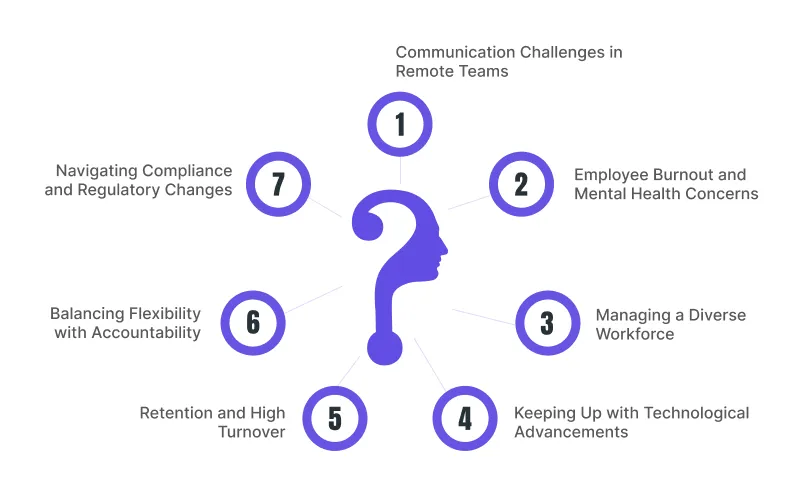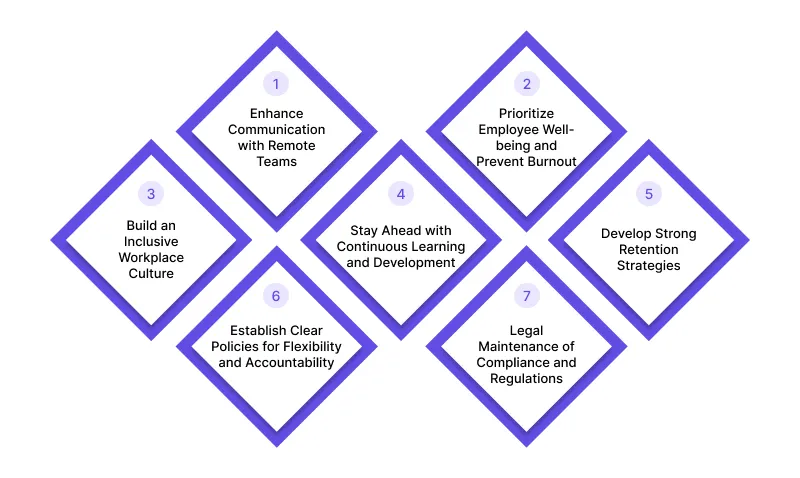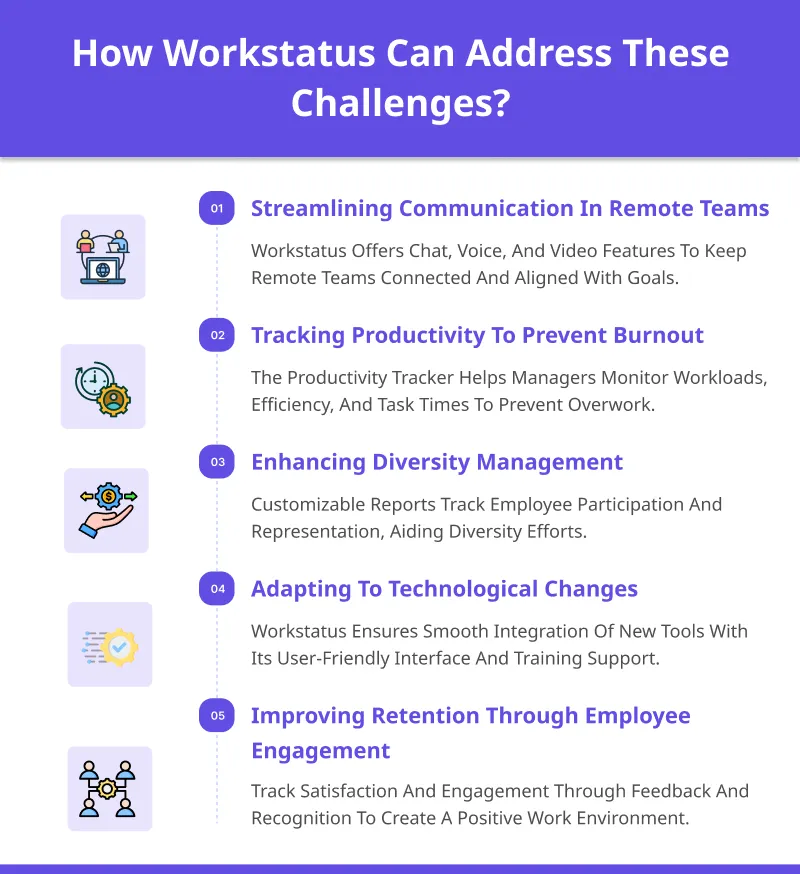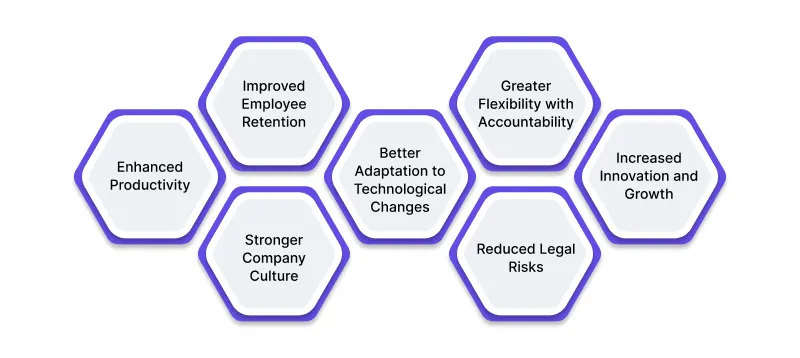Table of Contents
Employers face workplace challenges that were unimaginable just a few years ago in today’s rapidly evolving workplace. The rapid advancement of technology, the option to work from home, and the increasing demands of employees for better working conditions have all led to a swift transformation in the workplace.
However, along with these changes come new obstacles that can be challenging to navigate at times.
The workplace challenges are genuine, from maintaining effective communication with remote employees to focusing on avoiding burnout. Employers also deal with issues such as diverse workforces, updating their business to the newest technology, keeping their best employees, and legal compliance.
But don’t worry; these workplace challenges are not impossible to overcome. In fact, with adequate solutions, these are not problems but employee challenges that you can transform into strengths to chart a successful course.
Now, it is time to discuss the real-life problems working employers are experiencing nowadays and how they can try to solve them effectively.
Let’s get started!
The Shift In Technology, Remote Work, and Employee Expectations
The nature of the work environment is continuously changing due to technological developments, the increase in remote work, and changing employees’ expectations regarding the workplace.
These changes are slowly transforming how companies work and the workforce engages with work and colleagues.
Technology is now at the center of several organizations’ working practices. Technologies like the cloud, artificial intelligence, and collaboration tools are improving efficiency and transforming work.
While these technologies enhance efficiency and flexibility, they also incur certain costs, such as timely updates and dependency on technology.
Working remotely has become permanent in the modern workplace. Organizations must find ways to improve communication and team spirit as people work from different places.
Remote work has also brought about changes in work-life balance patterns, which include the flexibility of working from home and the difficulties of creating a work-life balance.
Another factor is that employee expectations are also rising. Employees no longer just go to work to earn money; they also look for passion, career advancement, and reasonable working hours.
In this case, employers must transform their management approach to meet these new demands, including providing professional development activities and a workplace culture.
Managing these changes is a matter of weighing the benefits of new technology with the person at work. Organizations must cope with issues to continue production and meet employees’ demands.
Thus, adopting these shifts can promote a more vibrant, active, and productive level at work.
7 Common Problems Faced by Employers

As the owners of their respective companies, the CEOs and founders are better positioned to nurture their firms through the realities of the current business world. However, rapid change brings issues that must be managed efficiently.
The following seven common employee challenges:
1. Communication Challenges in Remote Teams
When teams work remotely, communication is often ineffective. A lack of clarity in the messages delivered at different organizational levels can result in confusion and a lack of cohesion, making it challenging to ensure everyone agrees.
2. Employee Burnout and Mental Health Concerns
Employees feel pressure to perform in a competitive environment, which can worsen their working conditions and demoralize them. CEOs and founders must balance catering to their teams and meeting organizational objectives.
71% of remote workers stated that working from home helps them better balance their professional and personal lives.
3. Managing a Diverse Workforce
The key issues faced with diversity management are the conditions that enable equal respect and treatment of all employees. This means that leadership should be wise enough to bring people from different cultures together without possibly causing conflict.
4. Keeping Up with Technological Advancements
As technology advances, regular spending on equipment and staff development is required. Management needs to balance innovativeness without compromising the organization’s operations.
5. Retention and High Turnover
Another important reason is that an excessively high turnover rate may lead to negative consequences such as disruption of business processes and high costs. Managers must cultivate good employee retention practices that meet the requirements of the employees and the company.
6. Balancing Flexibility with Accountability
Flexibility is becoming more critical, yet it is often difficult to account for one’s work and time in such conditions. Managers must develop policy guidelines that promote flexibility without compromising the organizational outcomes.
7. Navigating Compliance and Regulatory Changes
A significant concern for companies is maintaining compliance with constantly evolving statutes, especially while venturing across borders. Noncompliance with these requirements attracts severe fines and reputational loss to the business firm.
Solutions to Address Workplace Challenges

Here are the helpful solutions to address workplace challenges:
1. Enhance Communication with Remote Teams
Use reliable communication platforms such as Slack, Microsoft Teams, and Zoom to ensure clear and effective communication. Virtual management meetings and daily briefings are also essential to maintaining order among the remote teams.
Implementing effective communication models is crucial because such a situation requires all members to remain informed about the processes.
2. Prioritize Employee Well-being and Prevent Burnout
Support mental health through counseling services, wellness programs, and flexible work and school schedules. Promote an environment where workers do not hide their difficulties. Daily check-ins and encouraging employees to maintain healthy work-life balance can significantly assist in preventing burnout.
3. Build an Inclusive Workplace Culture
Organize diversity and inclusion initiatives that foster the recognition of differences and work across diverse groups. Explain the diversity policy to all employees and ensure that diversity discussions start.
It is crucial to ensure the inclusion of everybody in decision-making processes so that everyone’s opinion is respected.
4. Stay Ahead with Continuous Learning and Development
Enroll your employees in training courses to update them with recent technological improvements. Promote the culture of learning by providing your staff with manuals, seminars, and training materials to assist them when transitioning to new tools and platforms.
5. Develop Strong Retention Strategies
Assign clear career tracks and provide incentives and awards for employees’ achievements. This will also prevent employees from searching for other companies that offer better wages, benefits, and promotion eligibility.
Daily check-ins, weekly/every fortnight appraisals, and engagement pulse checks also glimpse the employee’s overall satisfaction and issues.
6. Establish Clear Policies for Flexibility and Accountability
Introduce guidelines that define how freelancers and employees ought to work from home, as well as goals and timelines.
Promote accountability and schedule the systematic tracking of work activity. Achieving harmony between flexibility and control increases productivity while satisfying employees’ needs.
7. Legal Maintenance of Compliance and Regulations
Carry out compliance checks frequently and ensure you are up-to-date with your business sector’s compliance requirements. Engage legal advisors so you do not violate laws within the countries you intend to expand into.
Getting ahead of compliance minimizes legal concerns and potential fines.
How Workstatus Can Address These Challenges?
Here’s how Workstatus can support CEOs, founders, and their teams:

Benefits of Addressing Workplace Challenges

Here are the prominent benefits of addressing these challenges:
1. Enhanced Productivity
When communication is effective, employees are well equipped, and as a result, productivity is affected. Thus, teams can work more efficiently, achieve planned tasks, and positively contribute to the company’s activity without interference.
2. Improved Employee Retention
Reducing burnout, increasing a focus on work-life balance, and providing career progression to the workforce increases overall staff satisfaction. This, in turn, decreases turnover, resulting in the keeping of valuable employees and fewer expenses for finding new employees and their orientations.
3. Stronger Company Culture
Emphasizing diversity and inclusion creates a healthy workplace environment. Employees who feel valued and respected in their workplace will likely work harder, be more productive, and be committed to the company’s performance.
4. Better Adaptation to Technological Changes
Learning and adopting technology to keep up with constant change makes the company a market leader. This smooths operations and helps the organization gain a competitive advantage in the market.
5. Greater Flexibility with Accountability
Appropriate levels of flexibility and accountability allow the employees to receive a warm and innovative environment while preventing slacking off. This balance helps to encourage creativity and new ideas when excellent work must also be achieved.
6. Reduced Legal Risks
Adhering to the newly implemented regulatory measures reduces the probability of legal suits, penalties, and adverse brand images among customers. Hence, proactive compliance management assists in enhancing the trust of regulatory authorities and the overall market.
7. Increased Innovation and Growth
When leaders appropriately intervene in a task by tackling challenges faced in the workplace, they are making room for innovation. Engaging employees boost their creativity and takes the lead to produce excellent results, which will prosper the company.
Closing Thoughts
Managing people is never easy, especially not in today’s modern workplace, but by focusing on these areas as critical concerns, you can foster a focused, stimulated, and robust workforce.
As you go through all these steps to solve these problems, you are progressively working towards a better and more sustainable business, especially in forcing a better communication system and being in tune with advancing technologies.
However, remember that all these challenges should be met with practical solutions like Workstatus that are friendly to the company’s objectives and processes.
Therefore, these challenges can be conquered through maintaining a positive culture, investing in a team, and being flexible, which will take your business a long way.
The current modern workplace could also present many challenges, but these things can be worked around to be strengths.
FAQs
Ques: Can Workstatus assist in preventing employee burnout?
Ans: Yes, Workstatus records employees’ working hours and efficiency levels to determine times of burnout. This ensures that the workload is well managed and that work-life balance policies can be effectively introduced.
Ques: What makes Workstatus effective in balancing flexibility with accountability?
Ans: Workstatus helps you track working hours, manage tasks, and monitor performance patterns, which are essential for implementing flexible working arrangements efficiently. However, it is also necessary to account for working time properly and efficiently.
Ques: How does Workstatus ensure compliance with labor regulations?
Ans: Workstatus provides solutions to track work hours, manage payroll, and prepare reports, perfect for compliance and avoiding possible legal problems.











